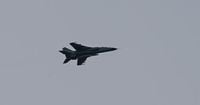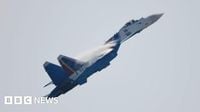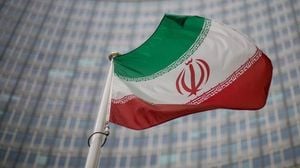Australia has once again found itself at the center of a tense military standoff in the South China Sea, after a Chinese fighter jet released flares dangerously close to a Royal Australian Air Force (RAAF) P-8A Poseidon maritime patrol aircraft on October 19, 2025. The incident, described by Australian officials as “unsafe and unprofessional,” unfolded while the Australian plane was conducting routine surveillance operations in international airspace—a mission that, according to the Australian Defence Department, aligns with international law and the longstanding principle of freedom of navigation and overflight.
The Australian government wasted no time in responding. On October 20, 2025, it lodged a formal diplomatic protest with Beijing, raising concerns both through the Chinese embassy in Canberra and via Australia’s embassy in Beijing. Defence Minister Richard Marles, who is also serving as acting prime minister, did not mince words. “It’s the proximity at which the flares were released that makes this unsafe and unprofessional,” Marles told Sky News, emphasizing that while encounters between military aircraft are not uncommon, the closeness of the flares in this instance posed a unique danger. “At a distance, it can be a means by which aircraft communicate… but if it is very close, then it can be dangerous. And that’s what we see is the case here.”
Thankfully, there were no injuries or damage reported, and the Australian crew landed safely. Yet, the risk was palpable. Marles noted that, had the flares been caught by a wind draught, they could have been sucked into the plane’s mechanisms—a potentially catastrophic scenario, given the P-8A Poseidon’s modified Boeing 737 airframe, which lacks the agility of a fighter jet. “It was dangerous, and it was unsafe, and inherent in that … it could have been a different outcome,” Marles said, underscoring the gravity of the situation.
This is not an isolated event. It marks at least the third such encounter in the past 18 months between Australian and Chinese military aircraft in the region. In February 2025, a Chinese jet reportedly dropped flares within 30 meters of an Australian surveillance plane. Similar incidents have occurred in May 2024 and even further back, with Australian forces on occasion having to take evasive action to avoid harm. The pattern has raised alarms not just in Canberra, but among Australia’s allies as well.
China’s response has been swift and uncompromising. The Southern Theater Command Air Force accused the Australian aircraft of “illegally intruding” into Chinese airspace over the Paracel Islands, a disputed cluster of islands also claimed by Vietnam and Taiwan. According to Senior Colonel Li Jianjian, the Australian jet “seriously infringed upon China’s sovereignty,” and Chinese forces mobilized to track and warn off the intruder. The Chinese military has described such incidents as grave violations, asserting that its actions were “lawful and restrained.”
Australia, however, rejects these claims. The Defence Department reiterated that its surveillance flights are conducted in accordance with international law, and that “all maritime claims must be consistent with the United Nations Convention on the Law of the Sea.” Australia maintains it has no territorial claims in the South China Sea but supports the rights of all nations to operate in international waters and airspace. “For decades, the ADF has undertaken maritime surveillance activities in the region and does so in accordance with international law, exercising the right to freedom of navigation and overflight in international waters and airspace,” a Defence spokesperson stated.
The timing of the latest incident is especially sensitive. It occurred as Australian Prime Minister Anthony Albanese was en route to Washington for a high-stakes meeting with U.S. President Donald Trump. The leaders were expected to discuss the Aukus security pact—a multi-billion dollar agreement between Australia, the U.S., and the UK to supply Australia with nuclear-powered submarines—as well as broader strategic and trade issues. The submarine deal, initiated during the Biden administration, is currently under review by the Trump administration to determine its alignment with the “America First” agenda. Albanese is also seeking to position Australia as a key supplier of rare earth minerals for the United States, especially after China moved to limit the supply of these critical materials earlier in the month.
The South China Sea remains a flashpoint in the broader contest for influence between China and the U.S.-led alliance. Beijing claims nearly the entire waterway, a position disputed by several Southeast Asian nations and rejected by Australia and its allies as lacking any legal basis. The region is not only a strategic military zone but also a vital commercial artery—most of Australia’s trade passes through these waters, making the rules-based order in the area fundamental to Australia’s national interests.
Political voices in Canberra are divided on how to respond. Shadow Defence Minister Senator Michaelia Cash called on Prime Minister Albanese to “condemn this dangerous action publicly” and to use his improved relationship with Beijing to secure an unequivocal commitment that such provocative actions will cease. “Australia cannot afford silence or half-measures when the safety of our servicemen and women is at stake,” she declared, warning that failure to extract such assurances would signal a lack of resolve on the world stage.
Observers expect Australia to press the issue at upcoming regional defence forums, advocating for transparency and a rules-based approach to military conduct in contested airspace. At the same time, officials are keen to keep diplomatic channels open, hoping to avoid further escalation. According to Reuters, the Australian Defence Department has reiterated its expectation that all countries, including China, “operate their militaries in a safe and professional manner.”
The episode also highlights the broader dilemma facing Australia—how to balance its deep economic ties with China, its largest trading partner, against its growing security dependence on the United States. This balancing act has only become more precarious as China asserts its military power in the region and as Canberra doubles down on its alliances, most notably through the Aukus pact.
For now, the skies over the South China Sea remain fraught with risk, and the diplomatic air is thick with tension. But as Defence Minister Marles made clear, Australia will continue to “assert the rules-based law around the South China Sea,” calling out unsafe and unprofessional conduct whenever it arises. After all, as both history and recent events show, the stakes—both for regional stability and for the safety of those in the air—could not be higher.





